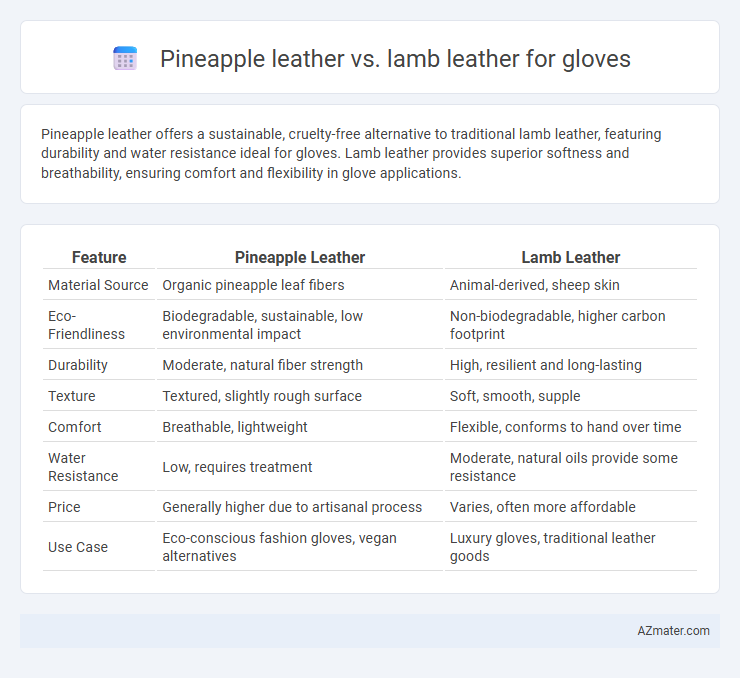Pineapple leather offers a sustainable, cruelty-free alternative to traditional lamb leather, featuring durability and water resistance ideal for gloves. Lamb leather provides superior softness and breathability, ensuring comfort and flexibility in glove applications.
Table of Comparison
| Feature | Pineapple Leather | Lamb Leather |
|---|---|---|
| Material Source | Organic pineapple leaf fibers | Animal-derived, sheep skin |
| Eco-Friendliness | Biodegradable, sustainable, low environmental impact | Non-biodegradable, higher carbon footprint |
| Durability | Moderate, natural fiber strength | High, resilient and long-lasting |
| Texture | Textured, slightly rough surface | Soft, smooth, supple |
| Comfort | Breathable, lightweight | Flexible, conforms to hand over time |
| Water Resistance | Low, requires treatment | Moderate, natural oils provide some resistance |
| Price | Generally higher due to artisanal process | Varies, often more affordable |
| Use Case | Eco-conscious fashion gloves, vegan alternatives | Luxury gloves, traditional leather goods |
Introduction to Pineapple Leather and Lamb Leather
Pineapple leather, also known as Pinatex, is an innovative, sustainable material derived from pineapple leaf fibers, offering an eco-friendly alternative to traditional leather with a lightweight, breathable texture ideal for gloves. Lamb leather, prized for its softness, suppleness, and durability, is sourced from young sheep, providing excellent flexibility and a luxurious feel often preferred in high-end glove manufacturing. Both materials offer unique benefits, with pineapple leather focusing on sustainability and lamb leather emphasizing premium quality and comfort.
Origin and Production Processes
Pineapple leather, also known as Pinatex, is an innovative sustainable material derived from pineapple leaf fibers, primarily sourced from the Philippines. The production process involves extracting long fibers from the pineapple leaves, which are then washed, dried, and felted into a non-woven mesh before being treated with a biodegradable resin to form a durable textile suitable for gloves. In contrast, lamb leather originates from young sheep skin, undergoing a tanning process that includes soaking, liming, and chrome or vegetable tanning to produce a soft, supple material renowned for its breathability and comfort in glove manufacturing.
Environmental Impact Comparison
Pineapple leather, derived from sustainable Pinatex fibers made from pineapple leaf waste, offers a significantly lower environmental impact than lamb leather, which relies on resource-intensive livestock farming contributing to high greenhouse gas emissions and land degradation. Pineapple leather production consumes less water and energy while generating minimal chemical pollution compared to the tanning process required for lamb leather, which often involves toxic substances harmful to ecosystems. Choosing pineapple leather gloves supports waste valorization and reduces carbon footprints, aligning with eco-friendly and cruelty-free fashion trends.
Physical Properties and Texture
Pineapple leather exhibits a lightweight, flexible texture with a slightly rough surface due to its fibrous composition, offering breathability and eco-friendly durability ideal for gloves. Lamb leather is renowned for its ultra-soft, smooth texture combined with high elasticity and exceptional tensile strength, providing a luxurious feel and superior dexterity. While pineapple leather has a matte finish and natural grain irregularities, lamb leather typically features a uniform, fine grain with a glossy sheen that enhances its tactile comfort and resilience.
Durability and Longevity
Pineapple leather, made from natural pineapple leaf fibers, offers impressive durability with resistance to water and scratches, making it a sustainable alternative to traditional materials. Lamb leather, known for its softness and flexibility, provides excellent longevity when properly maintained but is more prone to wear and tear over time. For gloves, pineapple leather combines eco-friendly durability with consistent structural integrity, while lamb leather delivers superior comfort with a need for more careful upkeep to preserve its lifespan.
Comfort and Breathability
Pineapple leather, made from natural pineapple fibers, offers superior breathability and moisture-wicking properties compared to traditional lamb leather, enhancing overall glove comfort during extended wear. Its lightweight and porous structure allows better air circulation, reducing sweat buildup and skin irritation. Lamb leather, while soft and durable, tends to retain heat and moisture, making pineapple leather a preferable choice for gloves prioritizing ventilation and comfort.
Maintenance and Care Tips
Pineapple leather, made from sustainable Pinatex fibers, requires gentle cleaning with a damp cloth and air drying to maintain its texture and avoid water damage. Lamb leather, known for its softness and durability, benefits from regular conditioning with leather-specific oils to prevent cracking and maintain suppleness. Both materials should be stored in a cool, dry place away from direct sunlight to extend the lifespan of gloves.
Cost Analysis: Pineapple vs Lamb Leather Gloves
Pineapple leather gloves typically cost 20-30% less than lamb leather gloves due to lower raw material expenses and sustainable production methods. Lamb leather involves higher processing costs and premium pricing driven by its softness and durability. Cost-conscious consumers opting for eco-friendly alternatives often prefer pineapple leather for affordable yet stylish glove options.
Style and Design Versatility
Pineapple leather offers a unique, textured aesthetic that adds a modern, eco-friendly appeal to glove designs, making it a highly versatile option for fashion-forward styles. Lamb leather provides a classic, smooth finish prized for its luxurious feel and timeless elegance, allowing for refined and sophisticated glove designs. Both materials support diverse style palettes; pineapple leather excels in bold, sustainable fashion statements, while lamb leather suits traditional, high-end glove craftsmanship.
Ethical and Sustainability Considerations
Pineapple leather, made from sustainable pineapple leaf fibers, offers an eco-friendly alternative to traditional lamb leather by reducing animal cruelty and minimizing environmental impact through upcycling agricultural waste. Lamb leather production involves animal farming with higher greenhouse gas emissions, land use, and ethical concerns regarding animal welfare. Choosing pineapple leather gloves supports cruelty-free fashion and promotes circular economy principles in the leather industry.

Infographic: Pineapple leather vs Lamb leather for Glove
 azmater.com
azmater.com